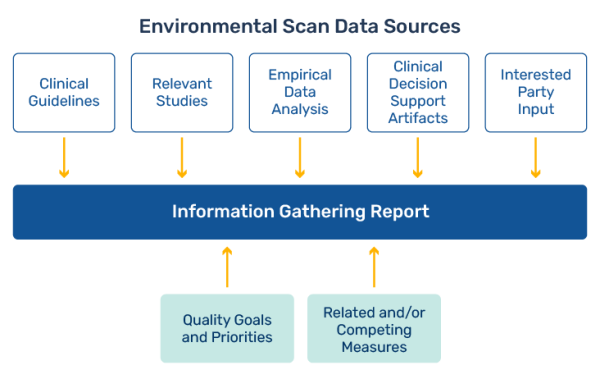Conduct an Environmental Scan
The environmental scan is essential in building the rationale for a quality measure. A broad-based environmental scan should include a strong review of literature, regulatory environment, economic environment, and interested party needs and capabilities. Performing a comprehensive environmental scan will improve the likelihood of project success.
Among the many important areas to scan, measure developers must consider the six domains of quality, outlined in Crossing the Quality Chasm (2001), which include safety, timeliness, efficiency, effectiveness, equitability, and patient centeredness. Also refer to the Meaningful Measures Initiative, which identifies the priorities for quality measurement and improvement.
Click to expand the (static) image.
The resulting report of the environmental scan will reflect the example data sources depicted in the graphic:
- Identification of related or competing measures, including opportunities for consolidation, harmonization, and alignment
- Listing of clinical guidelines pertinent to the clinical domain or topic
- Review of studies that document the success of measures in the same or similar health care setting or domain
- Discussion of scientific evidence supporting clinical solutions that might serve as a basis for the measure
- A review and evaluation of peer-reviewed and grey literature
- An assessment of clinical practice guidelines, legislation and regulations, and their implications on measurement
- The study of clinical decision support artifacts
- A list of existing related and competing measures
- A review of empirical data
- Discussion of expert input (including input from the technical expert panel and other experts)
- A summary of interested party input
- Tools & Resources for Environmental Scanning
Environmental Scans for Quality Measurement supplemental material
Find information on existing measures using tools and resources such as
- Environmental Scan Support Tool, a tool within the CMS Measures Inventory Tool (CMIT)
- De Novo Measure Scan, a tool within the controlled-access version of CMIT
- CMS Consensus-Based Entity (CBE) Submission Tool and Repository (STAR)
- Qualified Clinical Data Registry (QCDR) lists of measures. To review QCDR measures, go to the Traditional MIPS Overview website
- Conduct interviews with experts
- Post a Call for Measures to identify measures currently in use or under development
Analyze resources to identify any measures in current use that might be applicable for a new measure’s specific focus. Resources may include
- Employer, commercial, or managed care plans
- Core Quality Measure Collaborative
- Medicare Payment Advisory Commission
- CMS CBE Partnership for Quality Measurement
- National Academy of Medicine
- Institute for Healthcare Improvement
- Veterans Health Administration
- Defense Health Agency (e.g., TRICARE)

